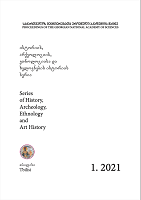ქართლის მეფე დარჩილი და მისი მეფობის ამსახველი ქრონიკები
THE KING OF KARTLI DARCHIL AND THE CHRONICLES DESCRIBING HIS LIFE
Author(s): Manana SanadzeSubject(s): Military history, Political history, Social history, Ancient World, 6th to 12th Centuries
Published by: საქართველოს მეცნიერებათა ეროვნული აკადემიის გამომცემლობა
Keywords: chronologically incorrect placement of the chronicle; Darchil; Vakhtang Gorgasali; Khosrow Anushiruwan; Caesar Justinian; Leonti Mroveli; Procopius of Caesarea; the Martyrdom of David and Costantine;
Summary/Abstract: Little has been known about the life of Vakhtang Gorgasali’s son and the king of Kartli - Darchil. Naturally, this is due to the scarcity of information about him both in the Georgian Chronicles and the chronicle of the Conversion of Kartli. Establishing the correct years of Darchil’s life has become possible through determining the exact years of the life and kingship of his father Vakhtang Gorgasali (470/71-531), on the one hand, and re-dating the martyrdom of David and Costantine, on the other hand. The study of the hagiographic work has shown that David and Costantine were not martyred during the invasion of Georgia by Arabs and Marwan ibn Muhammad (735-738); they were martyred at the initial stage of the Great Persian-Byzantine War (542/43), during Persian Shah Khosrow Anushiruwan’s invasion of Egrisi (western Georgian kingdom), known as Lazica in Byzantine historiography. According to the Martyrdom of David and Costantine, the sons of Vakhtang Gorgasali Darchil and Mihr (Mihrdat), fortified in the fortress of Anakopia, met the Persian commander sent by Khosrow to conquer Abkhazia, and started a fight against him. In this battle, Mihr (Mihrdat, younger brother of Darchil) was wounded on the battlefield and shortly he died. As for Darchil, he went back into the fortress. This campaign of the so-called “Marwan the Deaf” is also narrated by Leonti Mroveli in the section of the Georgian Chronicles describing the reign of Stepanos II - the Erismtavari of Kartli. Re-dating the martyrdom of David and Costantine has raised reasonable suspicions that the historical chronicle placed in the Georgian Chronicles after the section describing the reign of Patrician Stepanos II (mid 7th c.), which offers information identical to that of the Martyrdom of David and Costantine, was inserted in its current place by Leonti Mroveli (2nd half of the 11th c.) due to a huge chronological confusion, and similar to the same events narrated in the Martyrdom of David and Costantine, this too should be the case not of Arabs and Marwan the Deaf, but of the reign of the sons of Vakhtang Gorgasali and Persians – middle of the 6th c. Indeed, a detailed textual analysis of this section of the Georgian Chronicles has made it clear that the chronicle that Leonti Mroveli placed after Stepanos II - inasmuch as he considered the figures named there, the king of Kartli Archil and his brother Mihr (Mihrdat) to be the sons of Stepanos II - actually rendered information on the Great Persian-Byzantine War (542-562), the life of Vakhtang Gorgasali’s sons Darchil and Mihr and their fight against Persians. The correct dating of the above-mentioned events has given us the opportunity to contrast them with the narration of the Byzantine historian of the 6th c. Procopius of Caesarea, which further reinforced our conclusions. The correct dating of the chronicle inserted after the story on Stepanos II, and the identification of the persons mentioned in it has produced a result equal to discovering a new chronicle - the life of King Darchil of Kartli and his younger brother Patrician (Erismtavari) Mihr was completed with totally new materials.
- Issue Year: 2021
- Issue No: 1
- Page Range: 35-76
- Page Count: 42
- Language: Georgian

